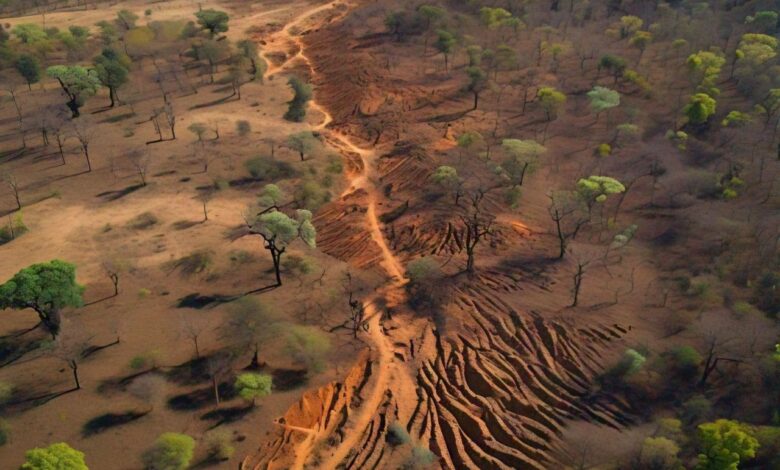Environmental Degradation in Zimbabwe: A Growing Concern

Environmental degradation in Zimbabwe has become a pressing issue, affecting millions of people across the country. The consequences of this problem extend beyond just the natural landscape. Furthermore, it is impacting human livelihoods and economic stability. In this article, we’ll explore the human cost of environmental degradation in Zimbabwe and examine potential solutions.
Devastating Impact on Rural Communities
Firstly, rural communities in Zimbabwe bear the brunt of environmental degradation. Land degradation costs each person $112 annually, amounting to $1.8 billion annually for the entire population 1. Also, this figure excludes indirect impacts such as reduced water supply and declining crop yields. The effects of land degradation are far-reaching. They contribute to increased poverty and food insecurity throughout rural areas.
Furthermore, there is deforestation, overgrazing and unsustainable agriculture. Moreover, mining activities continually lead to soil erosion and it also reduces agricultural productivity. Additionally, it leads to loss of biodiversity, contamination of water sources and disruption of local ecosystems. These factors result in significant reductions in crop yields. This is due to greater heat stress and more erratic rainfall patterns, further exacerbating the situation.
Economic Consequences
Secondly, the economic impact of environmental degradation in Zimbabwe cannot be overstated. Within the Mazowe Catchment alone, cultivated areas contribute a gross margin value of $68 million per year. Natural areas support a range of provisioning, regulating and cultural ecosystem services. This provides a benefit of $429 million per year 1. Therefore, this stark contrast highlights the importance of maintaining natural ecosystems alongside agricultural production.
Moreover, ecosystem inputs to livestock production are estimated at $65 million per year. This therefore emphasises the interdependence between natural ecosystems and agricultural systems 1. Wild resource harvesting, including wood, thatching grass, wild plant foods, mushrooms and honey, adds another $106 million annually to the economy.
Tourism also plays a crucial role in Zimbabwe’s economy. Rural tourism attractions in the Mazowe Catchment generates about $43 million or 4.6% of national tourism revenue 1. This underscores the importance of nature-based economic development in Zimbabwe.
Health Implications
Thirdly, environmental degradation in Zimbabwe has severe health implications for its citizens. Contamination of water sources due to land degradation poses significant risks to public health. Furthermore, loss of biodiversity can lead to reduced access to traditional medicines and increased vulnerability to diseases.
Climate change has contributed to greater heat stress, which can be particularly dangerous for vulnerable populations such as the elderly and young children. Additionally, erratic rainfall patterns also increase the risk of water-borne diseases during flooding events.
Cultural Heritage at Risk
Furthermore, environmental degradation threatens Zimbabwe’s rich cultural heritage. Many traditional practices and beliefs are closely tied to natural ecosystems. The loss of biodiversity and disruption of local ecosystems put these cultural practices at risk.
Additionally, the destruction of natural habitats may lead to the loss of sacred sites and ceremonial grounds, further eroding Zimbabwe’s cultural identity.
Policy Recommendations
Finally, to address the issue of environmental degradation in Zimbabwe, several policy recommendations have been proposed. The first includes scaling up climate-smart agriculture with emphasis on productive landscape solutions, food value chain and livelihood solutions and public policy and incentive solutions 1.
Also, investing in sustainable forest management to maintain the health and integrity of forest ecosystems, conserve biodiversity, mitigate climate change and provide livelihoods for communities dependent on forests 1. Lastly, leveraging climate finance and piloting payments for ecosystem services to incentivise sustainable landscape management and climate action 1.
The private sector can play a crucial role in these efforts through financing projects that contribute to sustainable landscape management. They can also direct financial flows away from projects with negative impacts on biodiversity and ecosystem services 1. Environmental fiscal policy reforms that value natural capital can provide incentives for the private sector to co-invest in the sustainable use of land and natural resources.
Conclusion
Environmental degradation in Zimbabwe poses significant challenges to human livelihoods, economic stability and cultural heritage. However, with concerted efforts from government, civil society and the private sector, it is possible to mitigate these effects and promote sustainable development.
By implementing policies that prioritise climate-smart agriculture, sustainable forest management and payments for ecosystem services, Zimbabwe can work towards reducing poverty and food insecurity while preserving its natural resources for future generations.
Ultimately, addressing environmental degradation in Zimbabwe requires a holistic approach that balances economic needs with environmental protection and social responsibility. By taking proactive steps now, Zimbabwe can avoid the devastating consequences of unchecked environmental degradation and create a more resilient and sustainable future for its people.




